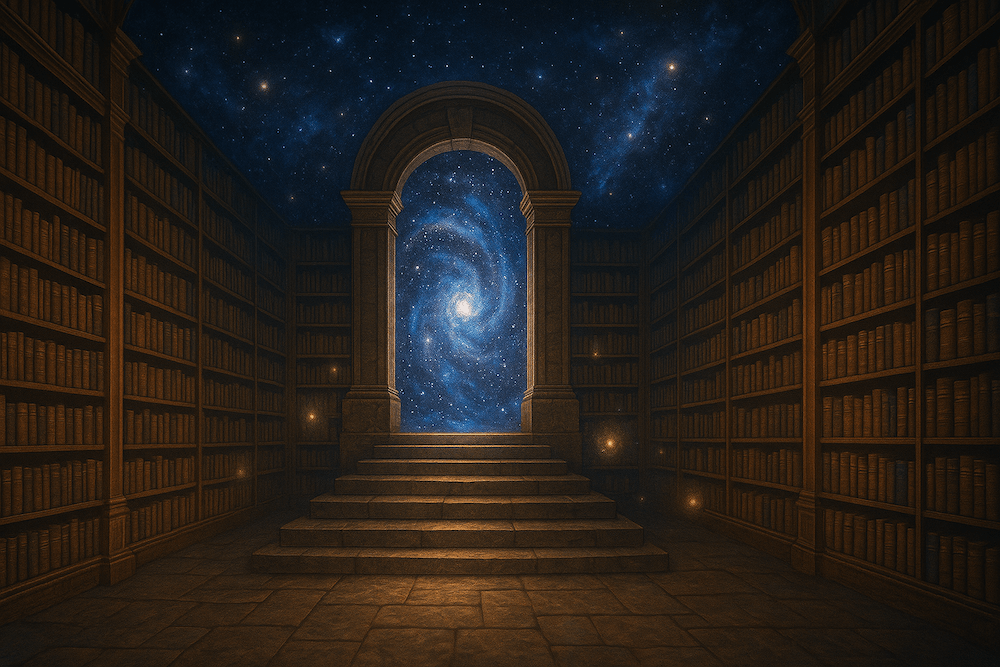The mystical library that holds all of human knowledge and experience. How to get to the cosmic consciousness database.
The Akashic Records are one of the most interesting metaphysical ideas that connect ancient wisdom with modern consciousness studies. These mystical archives are said to be a universal memory bank that holds every thought, feeling, and action that has ever happened or will happen. They are humanity's deepest search to understand the nature of existence and our place in the cosmic order.
The Akashic Records, which come from the Sanskrit word "Akasha," which means "ether," "sky," or "atmosphere," say that all of universal memory is stored in a non-physical dimension that can only be reached through higher states of consciousness. This idea says that reality is more than what our senses can pick up; it is an interconnected web of information that goes beyond time and space.
Historical Origins and Development
The foundation of Akashic Records theory rests deeply within ancient Hindu philosophy, where Akasha represents one of the five fundamental elements alongside earth, water, fire, and air. In Vedic tradition, Akasha was understood as the primordial substance from which all other elements emerge, a cosmic medium that permeates all existence.
The modern interpretation of Akashic Records emerged in the late 19th century through the influential work of Helena Blavatsky, co-founder of the Theosophical Society. Blavatsky introduced Western audiences to this concept after studying with Tibetan monks, characterizing it as "indestructible tablets of the astral light" that record both past and future human thought and action. Her contemporary, Alfred Percy Sinnett, further developed these ideas in his 1883 work "Esoteric Buddhism," helping to establish the conceptual framework that would influence decades of spiritual exploration.
The concept gained widespread recognition through Edgar Cayce (1877-1945), known as the "Sleeping Prophet," who claimed to access the Akashic Records during trance states to provide psychic readings for thousands of individuals. Cayce's documented cases brought the concept into mainstream consciousness, establishing him as one of the most influential figures in 20th-century metaphysical studies.

Rudolf Steiner, the Austrian philosopher and founder of Anthroposophy, incorporated Akashic Records into his spiritual science framework between 1904 and 1908, using the concept to describe the purported histories of lost civilizations like Atlantis and Lemuria. His work demonstrated how the Akashic Records concept could be applied to understanding collective human history and evolution.
Scientific Perspectives and Modern Interpretations
Contemporary scientists and philosophers have attempted to bridge the gap between ancient mystical concepts and modern physics. Ervin Laszlo, a prominent systems theorist and philosopher of science, has proposed the most comprehensive scientific interpretation of the Akashic Field in his groundbreaking work "Science and the Akashic Field: An Integral Theory of Everything."
Laszlo suggests that the Akashic Field corresponds to the quantum vacuum or zero-point field in modern physics. This field, he argues, consists of "a subtle sea of fluctuating energies from which all things arise: atoms and galaxies, stars and planets, living beings, and even consciousness." He proposes that this quantum vacuum serves as the universe's memory, storing and conveying information through space and time.
"The Akashic Field is the constant and enduring memory of the universe. It holds the record of all that has happened on Earth and in the cosmos." - Ervin Laszlo
The holographic universe theory provides another scientific framework for understanding the Akashic Records. This theory suggests that all information in the universe is encoded on a two-dimensional surface and projected as three-dimensional reality, similar to how the Akashic Records are said to contain all universal information in a non-physical realm that influences our observable reality.
However, the scientific community remains largely skeptical of Akashic Records claims. Critics point out the lack of empirical evidence and the difficulty of studying non-physical phenomena using conventional scientific methods. The concept's non-empirical foundations and association with metaphysical practices make it challenging to validate through traditional scientific investigation.
Accessing the Records: Methods and Practices
Traditional approaches to accessing the Akashic Records emphasize the importance of proper preparation, intention, and spiritual protection. Most methods begin with creating a sacred space and entering a meditative state through various techniques including deep breathing, visualization, or mantra repetition.
The "Pathway Prayer," developed by teacher Linda Howe, has become one of the most widely used methods for accessing the Records. This prayer involves requesting permission from "the Masters, Teachers, and Loved Ones" to open one's individual Records. Practitioners emphasize the importance of approaching this work with reverence, clarity of intention, and ethical considerations.
Meditation techniques specifically designed for Akashic access often involve visualizing a cosmic library, imagining golden books containing one's soul information, or connecting with spiritual guides who facilitate the process. Advanced practitioners may use techniques involving astral projection, shamanic breathwork, or energy field manipulation.
Practitioners stress that the experience should always feel loving and positive. Negative experiences during attempts to access the Records are generally attributed to unresolved psychological issues or insufficient spiritual preparation rather than the Records themselves.
Modern Applications and Critical Analysis
Contemporary practitioners use Akashic Records readings for various purposes including personal healing, spiritual guidance, understanding relationship patterns, and exploring life purpose. These sessions typically involve trained readers accessing the Records on behalf of clients to provide insights into current life challenges and spiritual development.
Despite its popularity in spiritual communities, the Akashic Records concept faces significant scientific and philosophical challenges. The primary criticism centers on the lack of empirical evidence for non-physical information storage systems and the absence of testable hypotheses that could validate the concept through conventional scientific methods.
Skeptics argue that reported Akashic Records experiences can be explained through psychological mechanisms including unconscious information processing, confirmation bias, and the tendency to find patterns in ambiguous information. The subjective nature of the experiences makes them difficult to verify objectively.
Cultural Impact and Future Research
The Akashic Records concept has influenced various aspects of contemporary culture including literature, film, music, and spiritual practices. The idea resonates particularly strongly in an era of information technology and global connectivity, with the concept of a universal database containing all information paralleling humanity's creation of digital networks and artificial intelligence systems.
Several emerging fields of study may provide new ways to investigate concepts related to the Akashic Records. Advances in consciousness research, quantum biology, and information theory continue to reveal unexpected connections between mind, matter, and information that could potentially support or refute aspects of the Akashic Records hypothesis.
Conclusion: Memory, Meaning, and Mystery
The Akashic Records represent one of humanity's most ambitious attempts to understand the nature of consciousness, memory, and universal connection. Whether approached as literal reality, useful metaphor, or psychological tool, the concept addresses fundamental questions about the nature of existence and our place within the cosmic order.
While scientific validation remains elusive, the enduring appeal of the Akashic Records suggests they fulfill important psychological and spiritual needs. The practices associated with accessing the Records can provide genuine benefits including enhanced self-awareness, stress reduction, and expanded perspective on life challenges.
Perhaps most importantly, the Akashic Records concept reminds us that human experience extends far beyond what can be measured and quantified through conventional means. Whether or not universal memory banks exist in some cosmic library, the human capacity for transcendence, wisdom, and connection to something greater than ourselves remains one of our most remarkable characteristics.
